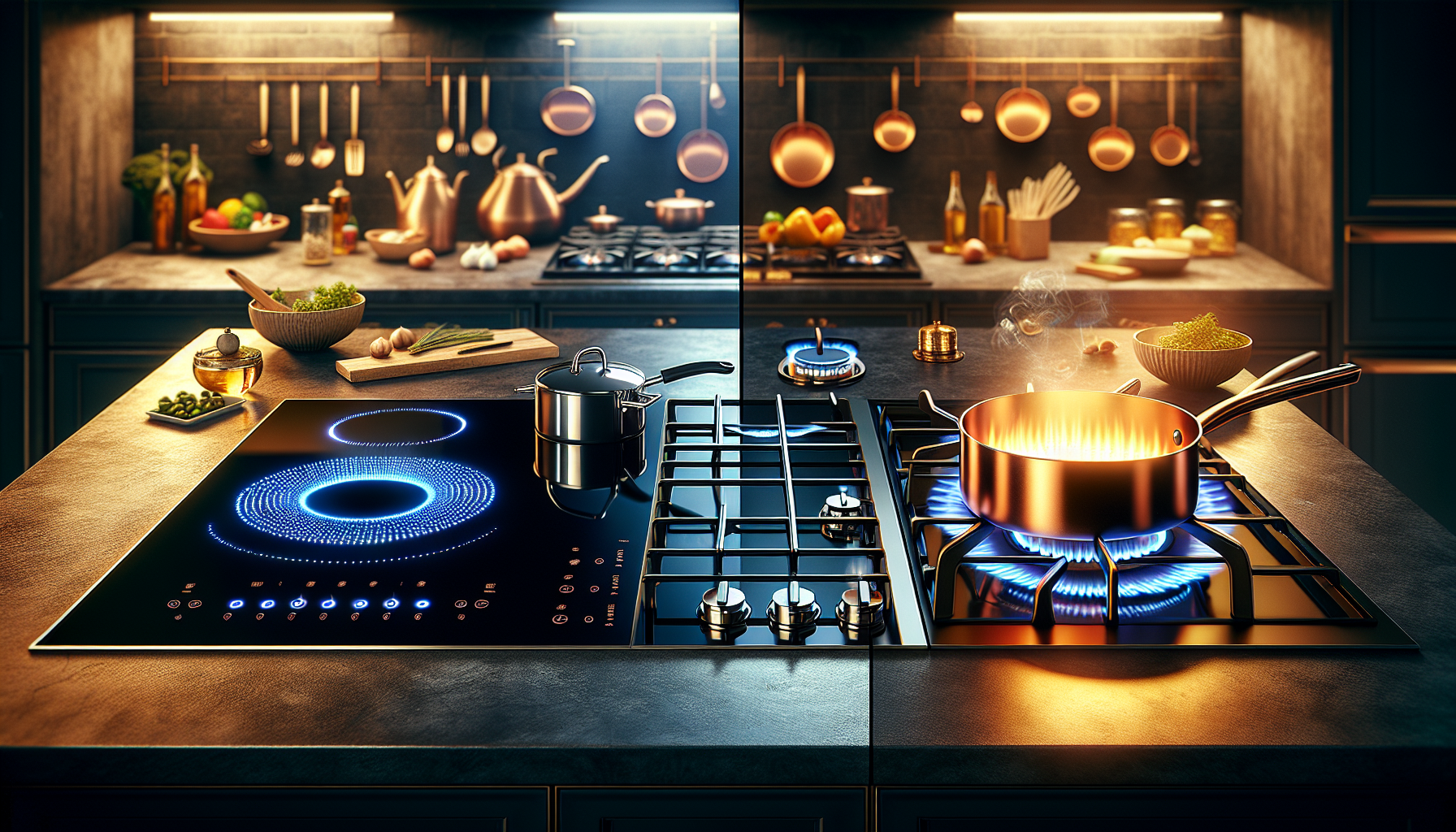
Induction Hob vs Gas: Comprehensive Advantages and Disadvantages
In this article, we'll dive into the nitty-gritty of induction hobs and gas cooktops. We'll look at how they stack up in terms of heating efficiency and speed, and explore their impact on your energy bills. Safety is another crucial factor, so we'll break down the features that set these two apart. By the end, you'll have a clear picture of what each option brings to the table, helping you decide which one fits your cooking style and needs best.
Heating Efficiency and Speed
When you're deciding between an induction hob and a gas stove, heating efficiency and speed are crucial factors to consider. Let's break down how each option performs in these areas.
Induction Hob Performance
Induction cooking has gained popularity for good reason. It creates heat directly inside the pan's steel base, which means there's virtually no wasted energy. This method is incredibly efficient, with about 84% of the energy being used to cook your food. What's more, induction cooktops heat up remarkably fast. In fact, they can boil water in just 5.8 seconds, which is significantly quicker than gas stoves.
Another advantage of induction cooking is its responsiveness. You can adjust the temperature instantly with a touch of a button, giving you precise control over your cooking. This responsiveness is similar to what you'd expect from a gas stove but without the open flame.
Gas Hob Performance
Gas stoves have been the go-to choice for many professional chefs due to their quick response and visual feedback. When you turn on a gas burner, you get immediate heat, and you can easily see the flame intensity. This visual cue helps you gage the heat level at a glance.
However, gas stoves are less efficient than induction cooktops. They typically operate at about 40% efficiency, which means a significant amount of heat is lost to the surrounding air. This inefficiency can lead to longer cooking times and higher energy consumption.
Efficiency Comparison
To put things into perspective, let's compare the efficiency of induction and gas cooking:
| Cooking Method | Efficiency |
|---|---|
| Induction | 84% |
| Gas | 40% |
This stark difference in efficiency translates to real-world benefits. Induction cooking not only saves energy but also reduces cooking time. It's estimated that induction cooking can cut cooking time by 20% to 30% compared to gas stoves.
It's worth noting that the efficiency of induction cooking remains high even when considering the entire energy chain. Even if the electricity comes from a natural gas power plant, the overall efficiency of induction cooking (around 47.9%) still outperforms direct gas cooking.
Energy Consumption and Cost
When you're weighing up induction hobs against gas cooktops, energy consumption and cost play a big role in your decision. Let's break down how these two options stack up.
Induction Hob Energy Usage
Induction hobs are champions of energy efficiency. They convert up to 90% of their energy into heat, which means less waste and more cooking power. This high efficiency translates to quicker cooking times and lower energy bills. In fact, you can boil water almost twice as fast with an induction hob compared to an electric one, and significantly quicker than with gas.
Gas Hob Energy Usage
Gas hobs, while popular, aren't as efficient as their induction counterparts. They typically operate at about 40-55% efficiency, which means a lot of heat escapes into the air around your pots and pans. This inefficiency can lead to longer cooking times and higher energy consumption.
Long-term Cost Analysis
When it comes to running costs, the picture isn't as clear-cut as you might think. Currently, the cost difference between using an induction hob and a gas hob is minimal. Depending on energy prices in your area, an induction stove could save you or cost you around $20 a year compared to gas.
Here's a quick comparison:
| Cooking Method | Energy Efficiency | Cost to Cook a Chicken Stir Fry |
|---|---|---|
| Induction | 84% | 10.88p |
| Gas | 40-55% | 6.9p |
While the gas option appears cheaper for a single meal, remember that induction's higher efficiency can lead to lower utility bills over time. Also, as we move towards cleaner energy sources, induction hobs powered by renewable electricity will become increasingly eco-friendly and potentially more cost-effective in the long run.
Safety Features
When you're choosing between an induction hob and a gas cooktop, safety is a crucial factor to consider. Both options have their own unique safety features and potential risks. Let's take a closer look at how they compare.
Induction Hob Safety
Induction hobs have several safety advantages that make them an attractive option for many households. One of the most significant benefits is their cooler surface. Since the heat is generated directly in the cookware, the cooking surface itself stays relatively cool. This feature significantly reduces the risk of burns, making it a safer choice, especially if you have children or pets in your home.
Another safety perk of induction hobs is their built-in safety mechanisms. If you accidentally turn on the hob without a pan in place, nothing will happen. The same goes for when you remove a pan from the cooking surface – the energy transfer stops immediately. This feature prevents accidental heating and potential fire hazards.
Gas Hob Safety
Gas hobs, while popular among many cooks, come with some safety concerns. The most obvious is the open flame, which poses a fire risk if not properly managed. Additionally, gas stoves produce pollutants like nitrogen dioxide (NO2), formaldehyde, and benzene, which can harm your health.
Recent studies have shown that these pollutants can reach hazardous levels in your kitchen. For instance, NO2 concentrations from gas stoves often exceed safety standards set by environmental agencies. This has raised concerns about the long-term health effects of using gas stoves, particularly in poorly ventilated spaces.
Safety Comparison
When comparing the safety aspects of induction and gas hobs, induction comes out on top in several areas:
- Fire risk: Induction hobs have no open flame, reducing the risk of fire.
- Burns: The cooler surface of induction hobs decreases the potential for burns.
- Air quality: Induction cooking doesn't produce harmful pollutants like gas stoves do.
- Automatic shut-off: Induction hobs stop working when cookware is removed, adding an extra layer of safety.
However, it's worth noting that both types of cooktops can contribute to indoor air pollution when cooking certain foods. Good ventilation, such as using a range hood or opening windows, is crucial for maintaining air quality regardless of the cooking method you choose.
Conclusion
Choosing between an induction hob and a gas cooktop boils down to your personal needs and preferences. Induction hobs shine when it comes to efficiency, speed, and safety, making them a great pick for those who value these aspects. They're particularly handy in homes with kids or for folks who want to cut down on energy use. Gas stoves, on the other hand, still have their fans among chefs who love the instant heat and visual feedback of a flame.
In the end, both options have their strengths. Your decision might depend on factors like your cooking style, energy costs in your area, and how much you care about air quality in your kitchen. Whichever you choose, remember that good ventilation is key to keeping your cooking space healthy and comfortable. So, weigh your options, think about what matters most to you in the kitchen, and pick the cooktop that'll help you whip up your favorite dishes with ease.
FAQs
1. What are the drawbacks of using an induction hob?
Induction hobs, while fast, require getting used to a different rhythm and pace of cooking compared to gas or electric hobs. New users might find the disappearing touchscreens confusing, and the fact that the hob turns off automatically when pans are removed can also be disorienting initially.
2. Which is more efficient, a gas hob or an induction hob?
Induction hobs are significantly more efficient than gas hobs because they utilize all the generated heat without any wastage.
3. What are some disadvantages of induction cooktops?
Induction cooktops present several disadvantages including the distinct feel compared to gas cooking, the potentially high cost of switching from gas to electric, the requirement for specific types of cookware, possible noise during operation, and the need for an analog thermometer.
4. Do professional chefs prefer using gas or induction hobs?
Many chefs prefer induction hobs due to their ability to heat up extremely quickly and control the temperature with precision. Induction technology heats the pan directly through a high-performance glass-ceramic surface, ensuring minimal heat loss to the surroundings, which is another reason chefs favor them.


